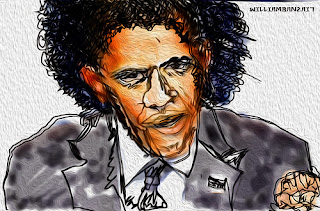 By Nanex Research:
By Nanex Research: Too bad that the bad guys on Wall Street who pulled off The Great Fed Robbery didn't pay attention in science class. Because hard evidence, along with the speed of light, proves that someone got the Fed announcement news before everyone else. There is simply no way for Wall Street to squirm its way out of this one.
Before 2pm, the Fed news was given to a group of reporters under embargo - which means in a secured lock-up room. This is done so reporters have time to write their stories and publish when the Fed releases its statement at 2pm. The lock-up room is in Washington DC. Stocks are traded in New York (New Jersey really), and many financial futures are traded in Chicago. The distances between these 3 cities and the speed of light is key to proving the theft of public information (early, tradeable access to Fed news).
We've learned that the speed of light (information), takes 1 millisecond to travel 186 miles (300km). Therefore, the amount of time it takes to transmit information between two points is limited by distance and how fast computers can encode and decode the information on both sides. Our experience analyzing the impact of hundreds of news events at the millisecond level tells us that it takes at least 5 milliseconds for information to travel between Chicago and New York. Even though Chicago is closer to Washington DC than New York, the path between the two cities is not straight or optimized: so it takes information a bit longer, about 7 milliseconds, to travel between Chicago and Washington. It takes little under 2 milliseconds between Washington and New York.
Therefore, when the information was officially released in Washington, New York should see it 2 milliseconds later, and Chicago should see it 7 milliseconds later. Which means we should see a reaction in stocks (which trade in New York) about 5 milliseconds before a reaction in financial futures (which trade in Chicago). And this is in fact what we normally see when news is released from Washington.
However, upon close analysis of millisecond time-stamps of trades in stocks and futures (and options, and futures options, and anything else publicly traded), we find that activity in stocks and futures exploded in the same millisecond. This is a physical impossibility. Also, the reaction was within 1 millisecond, meaning it couldn't have reached Chicago (or New York): another physical possibility. Then there is the case that the information on the Fed Website was not readily understandable for a machine - less than a thousandth of a second is not enough time for someone to commit well over a billion dollars that effectively bought all stocks, futures and options.
The Data
Minutes before the Fed announcement at 14:00 on September 18, 2013, there was significant activity in Comex Gold Futures (traded in Chicago) and the ETF symbol GLD (traded in New Jersey). This gives us an opportunity to measure closely, the exact (to the millisecond) amount of time between trading between these two instruments. The first two charts show about 3.5 minutes of time around the Fed Announcement release, giving us an overview. The stack of charts that follow allow you to easily compare between GLD (New York) and GC Futures (Chicago) for 6 different active periods. You will see that in the first 5 pairs - before the announcement, activity first shows up in GC Futures, followed by activity in GLD between 5 and 7 milliseconds later. In the last pair, which compares activity at exactly 14:00:00.000, you will see both GC futures and GLD react exactly at the same time.See also: More Charts of Evidence.
1. December 2013 Gold (GC) Futures trades on September 18, 2013 from 13:57 to 14:00:30.
2. GLD Showing Trades color coded by exchange on September 18, 2013 from 13:57 to 14:00:30
3. Zooming in 150 milliseconds of time for 6 different high activity periods minutes before and during the annoucement.
Compare Chart 1a with Chart 1b, then 2a with 2b, and so on. The last two show the event at 14:00:00 - notice those occur at the same time. This is physically impossible unless information was already present in Chicago and New York. It's easiest if you compare the bottom panels of each chart which shows trading volume for each millisecond.
Source: Nanex Research
Art by WB7 'Debt Brother'

No comments:
Post a Comment